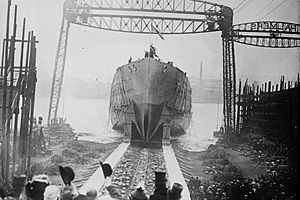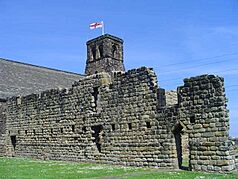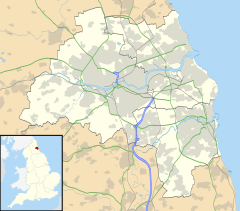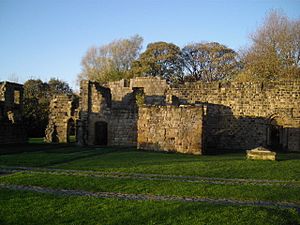Jarrow facts for kids
Quick facts for kids Jarrow |
|
|---|---|
| Town | |
|
|
|
| Population | 27,526 |
| OS grid reference | NZ332651 |
| Metropolitan borough |
|
| Metropolitan county | |
| Region | |
| Country | England |
| Sovereign state | United Kingdom |
| Post town | JARROW |
| Postcode district | NE32 |
| Dialling code | 0191 |
| Police | Northumbria |
| Fire | Tyne and Wear |
| Ambulance | North East |
| EU Parliament | North East England |
| UK Parliament |
|
Jarrow is a town in South Tyneside, England. It is located on the south side of the River Tyne, about 3 kilometres (2 miles) from the coast. In 2011, Jarrow and nearby areas like Hebburn had a population of 43,431 people. The town is also home to the southern entrance of the Tyne Tunnel.
Jarrow is famous for a few important things. In the 700s, Monkwearmouth–Jarrow Abbey was the home of The Venerable Bede. He was a very important scholar and is often called the "father of English history." Later, from the mid-1800s until 1935, Jarrow was a major centre for shipbuilding. It is also well-known as the starting point of the Jarrow March in 1936. This was a protest against unemployment.
Contents
History of Jarrow
What's in a Name?
The name Jarrow was first written down in the 700s. It comes from an old Anglian tribe called the Gyrwe. These people were known as "fen dwellers," meaning they lived in marshy, wet areas. This might refer to Jarrow Slake, which was once a wetland where the River Tyne and River Don met. The way the name is pronounced today, with a "J" sound, was influenced by the Normans.
Monkwearmouth–Jarrow Abbey
The Monastery of Saint Paul in Jarrow was part of a larger religious centre called Monkwearmouth–Jarrow Abbey. This abbey was the home of The Venerable Bede, a famous scholar. He wrote many important books, including Ecclesiastical History of the English People. He also translated parts of the Gospel of John into Old English.
Jarrow, along with the abbey at Wearmouth, became a major place for learning. It had one of the largest libraries north of the Alps. This was thanks to Benedict Biscop, who founded the abbey and travelled widely to collect books. In 794, Jarrow was attacked by Vikings, just one year after they raided Lindisfarne. The monastery was later closed down by King Henry VIII.
Today, the ruins of the monastery are part of the church of St. Paul. One wall of the church has the oldest stained glass window in the world, from around AD 600. Next to the monastery is Jarrow Hall. This is a museum where you can learn about Bede's life and times.
The world's oldest complete Bible, called the Codex Amiatinus, was made at this monastery. It was written in Latin and was meant to be given to the Pope. It is now kept in a library in Florence, Italy. Three copies of this Bible were started in 692. This was when the monastery got more land to raise 2,000 cattle. Their skins were used to make the vellum (a type of parchment) for the Bible's pages.
Jarrow from the 1800s to Today

Jarrow was a small town until big industries like coal mining and shipbuilding arrived. In 1852, Charles Mark Palmer opened a shipyard called Palmers Shipbuilding and Iron Company. It was the first company in the world to make armour-plate for ships. Palmer's shipyard built about 1,000 ships. These included the first iron screw collier (a ship that carried coal) and many important warships. The Jarrow Town Hall was built in Grange Road and opened in 1904.
Palmer's shipyard employed about 80% of the town's workers. But it closed in 1933. This happened during the Great Depression, a time of great economic hardship. The closure caused a lot of unemployment in Jarrow.
One of the most famous events in Jarrow's history is the Jarrow March. In 1936, unemployed workers from Jarrow marched all the way to London to protest. They wanted the government to do more about unemployment. Ellen Wilkinson, who was Jarrow's MP, wrote a book about these events called The Town That Was Murdered. The march helped to bring attention to the problems in areas with high unemployment.
In 1915, there was a train crash in Jarrow called the St Bedes Junction rail crash. Seventeen people died in this accident, which was caused by a signalman's mistake.
The Second World War (1939-1945) brought new life to Jarrow. The Royal Navy needed many ships built. After the war, the shipbuilding industry was taken over by the government. The last shipyard in Jarrow closed in 1980.
In 2014, a group of mothers organised another march from Jarrow to London. This time, they were protesting against changes to the NHS. Thousands of people took part in this event.
Education
Jarrow has a secondary school called Jarrow School. It used to be called Springfield Comprehensive. The school has been updated with modern learning facilities. It now has a special focus on engineering.
Demography
In 2011, Jarrow had a population of 43,431 people. This was a big increase from 27,526 in 2001. The main reason for this increase is that the town's boundaries changed.
Most of Jarrow's population is White British (97.1%). This makes Jarrow less diverse than other parts of Tyneside and its local area, South Tyneside.
Jarrow has a slightly higher rate of unemployment compared to the rest of the North East of England. In 2013, Jarrow's unemployment rate was 6.1%, while the North East average was 5.4%. However, the number of young people receiving unemployment benefits has gone down.
Notable People from Jarrow
Many interesting people have come from Jarrow:
- Roger Avon, an actor
- Bede, a famous monk and scholar
- Catherine Cookson, a well-known writer
- Steve Cram, an Olympic athlete, known as the "Jarrow Arrow"
- Ray Drinkwater, a goalkeeper for Queens Park Rangers F.C.
- Christie Elliot, a professional footballer
- Peter Flannery, a playwright
- William Goat, who won the Victoria Cross for his bravery
- Stephen Hepburn, a politician
- James Johnston, a socialist activist
- Ray Lugg, a professional footballer
- Jem Mace, a famous boxer
- Aidan McCaffery, a former Newcastle United F.C. footballer
- John Miles, a rock musician
- Fergus Montgomery, a Conservative MP
- Charles Mark Palmer, the shipbuilder and first mayor of Jarrow
- Alan Plater, a writer
- Alan Price, a musician
- Steve Robson, a songwriter and record producer
- David Sharpe, a silver medalist in athletics
- Gareth Smith, a cricketer
- Sir Patrick Stewart, a famous actor, lived in Jarrow as a child
- Paul Thompson, a rock musician and drummer for Roxy Music
- Jimmy Thorpe, a Sunderland A.F.C. goalkeeper
- Frank Williams, a Formula One team manager
- Ellen Wilkinson, a Labour MP and organiser of the Jarrow March
- Wee Georgie Wood, a music hall star
- Dan Neil, a Sunderland A.F.C. midfielder
Twin Towns
Jarrow is twinned with these towns. This means they have a special friendship and often share cultural events:
- Wuppertal in Germany
- Noisy-le-Sec in France
- Épinay-sur-Seine in France
See also
 In Spanish: Jarrow para niños
In Spanish: Jarrow para niños









